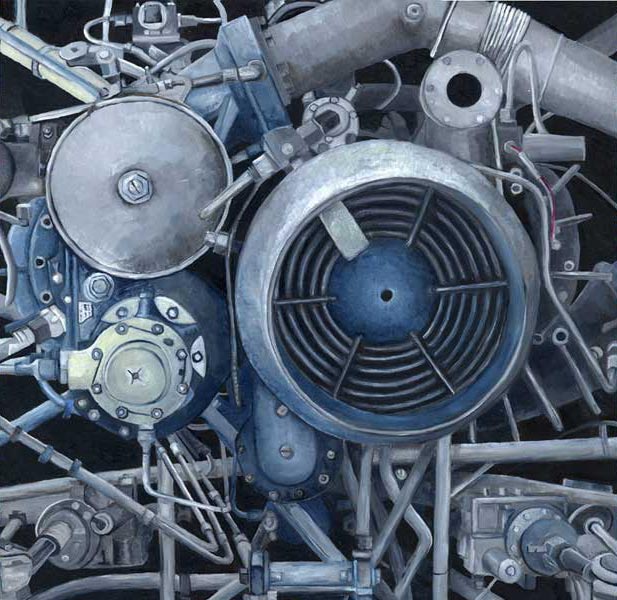 "The Patternists specialized in cerebral asymmetry. With grossly expanded right-brain hemispheres, they were highly intuitive, given to metaphors, parallels, and sudden cognitive leaps. Their inventive minds and quick, unpredictable genius had given them a competitive edge at first. But with these advantages had come grave weaknesses: autism, fugue states, and paranoia. Patternists grew out of control and became grotesque webs of fantasy." - Bruce Sterling Schismatrix Plus
"The Patternists specialized in cerebral asymmetry. With grossly expanded right-brain hemispheres, they were highly intuitive, given to metaphors, parallels, and sudden cognitive leaps. Their inventive minds and quick, unpredictable genius had given them a competitive edge at first. But with these advantages had come grave weaknesses: autism, fugue states, and paranoia. Patternists grew out of control and became grotesque webs of fantasy." - Bruce Sterling Schismatrix PlusWhy do I always need a reason? I swivel the focus of the spotlight onto the branding I've given myself for the last ten years, patterntology. Meant to look like a pseudo-scientific term, the study of patterns, is exactly right. I don't pretend to be a scientist but I know the human experience can be broken neatly down into this kind of metaphor. This grew out of the abstract painting I pursued for 18yrs which I tried to make look as much like something but not look like something. I looked hard at the masters of abstraction and followed, with historic meaning, in their footsteps.
Looking at a microscopic slide photo in a science magazine; you have no idea what it is unless you read the caption. I like to guess before I read the caption. I love that moment of wonder. It's a great Zen equalizer, "Could be anything." You get a taste of universe in that moment. Familiar but not and could be any scale, material, time. Patterns repeat in all those dimensions. I get fascinated with a certain form and then imagine what would happen if it multiplied and became an entire world onto itself with an entirely different physics founded solely on that form. I've treated the picture plane much like a 'sample' for years, inspired by the square microscope slip. Painting within a square canvas pulled me out of classic ideas of composition and forced me to mix things up, much like nature tends to randomize gracefully no matter how you cut it up. I end up looking harder rather than satiating a formulaic scene.

After painting realistic subjects for a year I realize I could meld the abstract process with realism. Textures become notes of music that can be interwoven to create a complete piece of music. Real life visions take the place of percussion, rhythm, lead riffs, keyboards, vocals... Overlapped and entwined into one symphonic visual piece. Everything I've ever seen or imagined can play a part in a painting.
I love the random process of abstraction because it allows you to change the whole painting every time you approach it. I love the solid recognizable detail of realism because it celebrates the sensual quality of seeing. If I can mix both, I will have found my art. A truly infinite vocabulary. Exciting new territory to explore, with total freedom.
Looking at a microscopic slide photo in a science magazine; you have no idea what it is unless you read the caption. I like to guess before I read the caption. I love that moment of wonder. It's a great Zen equalizer, "Could be anything." You get a taste of universe in that moment. Familiar but not and could be any scale, material, time. Patterns repeat in all those dimensions. I get fascinated with a certain form and then imagine what would happen if it multiplied and became an entire world onto itself with an entirely different physics founded solely on that form. I've treated the picture plane much like a 'sample' for years, inspired by the square microscope slip. Painting within a square canvas pulled me out of classic ideas of composition and forced me to mix things up, much like nature tends to randomize gracefully no matter how you cut it up. I end up looking harder rather than satiating a formulaic scene.

After painting realistic subjects for a year I realize I could meld the abstract process with realism. Textures become notes of music that can be interwoven to create a complete piece of music. Real life visions take the place of percussion, rhythm, lead riffs, keyboards, vocals... Overlapped and entwined into one symphonic visual piece. Everything I've ever seen or imagined can play a part in a painting.
I love the random process of abstraction because it allows you to change the whole painting every time you approach it. I love the solid recognizable detail of realism because it celebrates the sensual quality of seeing. If I can mix both, I will have found my art. A truly infinite vocabulary. Exciting new territory to explore, with total freedom.